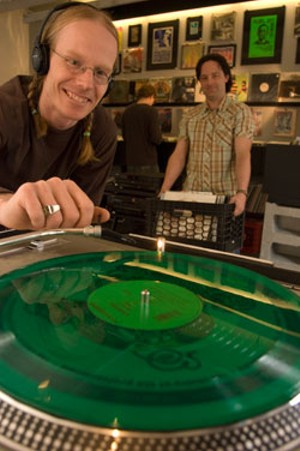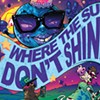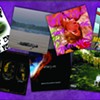Published April 8, 2009 at 8:17 a.m.
The response is almost Pavlovian. The grating, yet oddly comforting scratch of a needle landing on a rotating swath of black vinyl triggers a moment of heightened sensory awareness. Sonic salivation increases as tongue finds groove and that familiar, distant crackle emanates from a pair of speakers. And then, just at the apex of anticipation … well, it depends.
You could be a nightclub DJ cuing up the latest reggaeton single for an undulating mob. Or perhaps you’re alone in your living room, eyes closed, buried in headphones, oblivious to the outside world, awaiting Beethoven’s Fifth Symphony to wash over you in a flood of orchestral bliss. Or maybe you just wanna rock ’n’ roll all night to an old Kiss LP.
Whatever the aural fixation, the act of dropping a needle on a record can be among the most thrilling moments a music lover ever experiences. It is audiophilic foreplay, rife with sensuous possibilities. And it’s a phenomenon that really only happens with vinyl.
As technology has evolved, so too have sound-storage devices. That’s a basely sterile term, especially given the long-playing album’s romantic mystique, but a record is really just a storage unit. Same goes for any recording medium, from the earliest cylinder music boxes and phonograph 78s to 8-track cassettes to compact discs and, most recently, that scourge/savior of the music industry, mp3 files. But as each format has come and gone — inevitably replaced by technological advances — vinyl has remained a constant. If anything, records are actually growing in popularity, even in the digital storm of the iTunes Age.
According to Nielsen SoundScan, the industry standard for tracking retail music sales throughout the United States and Canada, LP album sales rose 14 percent between 2006 and 2007. In 2008, vinyl sales reached a whopping 1.88 million units, doubling the previous year’s total and marking the highest sales volume since Nielsen began tracking the format in 1991.
Conversely, CD sales declined by more than one-third over the same three-year period, as digital downloads continued to assert marketplace dominance. On the whole, the music industry experienced close to a 20 percent decline in retail sales across all formats in 2008, including digital downloads.
What, then, to make of the resurging interest in a format long thought to be nearly extinct? Wasn’t the advent of the cassette tape supposed to sound vinyl’s death knell? And wasn’t the CD supposed to do the same to both media?
And if file sharing and downloads — the music industry’s digital meteors — have fossilized CDs, how could such a cumbersome and technologically retro format as the record be thriving?
And yet it is. At record shops and flea markets everywhere, teenagers scour dollar bins for albums made when their parents were kids. Hardcore collectors lurk in the shadows of online auction houses waiting to pounce on unwitting sellers with treasure troves of rare wax. Audiophiles trade stereo remasterings of classic albums for the original mono versions, just to hear the difference. And some folks just dig on the groovy cover art.
The reasons vinyl holds a special place in the hearts, minds and, occasionally, pocketbooks of music consumers are as diverse and unpredictable as the collectors themselves. The easy answer is that there is no easy answer.
Then again, maybe it’s as simple as this: Records are really cool.
******
Side A: The (Re)birth of the Cool (Why Record Stores Matter)
Stop me if you’ve heard this one before: Independent record stores are dying out. And fast.
Sadly, that hypothesis is largely proving to be true. According to the Almighty Institute of Music Retail, a California-based marketing-programs and database services company, roughly 3500 independent record stores across the U.S. have closed since 2003. From monoliths such as Tower Records and Virgin Megastore to iconic indies such as Milwaukee’s Atomic Records, which shut its doors last month, the cutting edge of the digital age has spared neither David nor Goliath. Given the country’s current economic woes, expect that sobering trend to continue.
But the effects of that phenomenon run much deeper than adding a few jaded clerks to the unemployment line or forcing you to turn to eBay for your used-record fix. As globe-trotting foodie Anthony Bourdain has pointed out, the easiest entry point into an unfamiliar food culture is its outdoor food market. For a music fan, it’s a city’s record purveyors.
Record stores are the cultural centers of music communities; they’re as much a part of a music scene’s identity as are its bands and clubs. And you can tell a lot about a city by spending some time in a record store perusing the band flyers, local stacks and used bins. So it follows that when one closes, the negative effects reverberate widely.
But what about the rare occasion when a record store opens?
Jacob Grossi, 35, is hoping his new shop, Burlington Records, will provide the Queen City another door into its music community. The wiry, bespectacled collectibles fanatic also owns Montpelier’s Riverwalk Records and is keenly aware of the place such shops hold.
“Music is about so much more than the music itself,” Grossi says. “It’s the culture. It’s the look. It’s the feel. And a lot of that is being lost through digitization. You’re losing the physical element.”
That element — the rock ’n’ roll aesthetic — is evident throughout the small Bank Street storefront that formerly housed the Grannis Gallery. Original concert posters and show flyers dating back decades frame stacks upon stacks of vinyl — 5000 records now, with more on the way. Newspaper ads featuring the likes of Jimi Hendrix and The Who hang next to yellowed copies of Rolling Stone. Along a side wall, analog speakers stand guard over antiquated stereo equipment. The shop also sells vintage clothing on its second floor.
Grossi — whose uncle, Jack Grossi, was the owner of Tucson’s legendary PDQ Records — speaks at length about the physical properties of vinyl, and points to the quality of album art as a key factor in its appeal. Album art has necessarily gotten smaller over time, shrinking from 12-inch-square LP covers to CD sleeves to intangible jpeg files.
“As they’re losing [the physical element], a lot of people are trying to grab onto it,” Grossi says, referring to both the records and the associated memorabilia. “I mean, I still sell cassette tapes at my other shop.”
Ask vinyl enthusiasts why they love their records and sooner or later they’ll mention the sound. Though the exact descriptions may vary, the word “warmth” is almost certain to appear. But Grossi offers a different tack, particularly with regard to a couple of his favorites.
“I have a Chuck Berry on Chess [Records], “Schooldays,” where it’s not warmth at all,” he counters. “It’s just completely fucking dirty. The treble is almost crackly.” Grossi points out that the record doesn’t suffer from poor quality. “It sounds like it sounded when it was recorded … It’s the original sound.”
He adds that whenever an original recording of Otis Redding’s “(Sittin’on) The Dock of the Bay” comes in, he’ll play it in the store all day long before putting it out for sale. “There are those records that sound ‘warm,’” Grossi acknowledges. “But I like the ones that sound a little bit dirty.”
Given the perils facing record stores across the country, and the recession, Grossi’s timing is curious — perhaps coincidentally, the shop opened on April Fool’s Day. Furthermore, Burlington already has a handful of record stores (Pure Pop, Downtown Discs) and secondhand shops (Speaking Volumes, ReCycle North) that trade in vinyl. However, Grossi views his new venture not as competition to those stores but as a complementary piece. And he justifies his store in Burlington’s tightly knit music community by paradoxically refuting the notion that vinyl is making a comeback.
“It never fucking went anywhere,” he states adamantly.
******
Side B: They Call Me the Seeker (One Man’s Trash is Another Man’s Stash)
You probably won’t find David Colman at Burlington Records very often. Though the 71-year-old retiree says he might “check it out sometime,” the avid vinyl enthusiast prefers to do his own digging. In the summer months, the Shelburne resident spends his days bouncing from flea markets to yard sales, searching for the elusive diamond in the rough.
Colman represents a very different type of collector from those who frequent a shop like Burlington Records. Where casual collectors would be thrilled to snag a $20 reissue of The Beatles’ The White Album in stereo, Colman looks for the exponentially more valuable original mono version, which was released only in the UK and was the last Beatles record to feature a mono mix. He also looks for sellers who have no idea what is in their possession.
“I don’t really deal too much with guys like [Grossi], because they know the value of the records, as I do,” he says. “I buy from people who don’t know what the hell they’re doing, basically.”
Despite that provocative pronouncement, Colman’s quest for rare records, specifically 45s, is more about sentiment than swindle. For him, original vinyl represents a link to rock history, a subject about which he possesses near encyclopedic knowledge. But more acutely — and perhaps importantly — vinyl represents a concurrent link to his personal life story.
Asked about his collection — which was considerably downsized recently at the behest of his wife — Colman is almost instantly transported to his youth. More than physical records, he speaks of the formative experiences with music that would ultimately shape the course of his career: He was a disc jockey and on-air radio personality for Boston’s WHGH, Vermont stations WDEV and WVMT, and television station WCAX.
Gazing out the window of a Burlington coffee shop on a recent Wednesday morning, Colman recalls a number of remarkable concert experiences from his youth: Chuck Berry, Little Richard, Sinatra at the Sands. But his most telling story comes from his days in the Air Force. He was stationed in Biloxi, Miss., in 1955 when he met a then-little-known singer named Elvis Presley, who was performing on base at an airman’s club. “I told him he was gonna go places,” Colman says with a grin. One year later, Presley released “Heartbreak Hotel.” And the rest, as they say, is rock history — a history imprinted for all time on little vinyl discs.
Colman is a frequent visitor at Speaking Volumes, the secondhand shop on Burlington’s Pine Street owned by Norbert Ender. The 46-year-old native of Austria is fascinated with history in general, as the eclectic antiques, baubles and stacks of books around his store attest. But the centerpiece of his business is vinyl. Literally. Neatly organized stacks of LPs dominate the front section of the store. Ender estimates that records make up 60 percent of his retail sales, and that Colman is one of perhaps 20 or 30 regular vinyl shoppers who make at least weekly visits to check out the new arrivals. His is also one of the few shops outside of Radio Shack that will fix your busted turntable. That’s kind of a necessity for a vinyl fan.
Insatiable collectors and appreciators, Colman and Ender are kindred spirits. When they speak about the “value” of records, they mean more than the strict definition of the word — though both know what does and doesn’t lend a record monetary worth: condition, scarcity, errors, mono versus stereo, historical significance or, in rare cases, insignificance.
Ender is the proud owner of a truly singular piece of rock ’n’ roll ephemera: Live at the Brothers 4 by “Golden Joe” Baker, otherwise known as the world’s first Elvis impersonator. The record’s sleeve features Baker, clad in a rhinestone-studded silver leisure suit, standing atop the bar’s awning, arms spread wide, holding open, natch, a cape.
But aside from the snazzy getup, no one would ever confuse the man with The King — especially not Colman. Overweight, hairy and greasy, Baker bears scant resemblance to Presley — even the Fat Elvis — although Ender claims that the vocal impression is passable. While a sticker indicates the record’s book value of $400, its value to Ender appears to be priceless.
******
Side C: Not Fade Away (Commitment)
Unless records are sealed in temperature-controlled vaults away from sunlight, oily hands and, yes, needles, they will eventually deteriorate. And that’s to say nothing of the incalculable collections warping and gathering mold in dank basements and musty garages all over the world. Nostalgia is clearly an important element in vinyl collecting, but in order for the format to remain relevant, new records — with new music — must continue to be pressed.
No doubt in response to Nielsen’s findings, savvy record labels have begun to increase their production of vinyl, even though the format will never usurp more technologically advanced ones. You want further proof that the record renaissance crosses demographic boundaries (and is hence financially viable)? Last year’s top-selling vinyl album was Radiohead’s In Rainbows. The second? Abbey Road by The Beatles.
The music industry is still way behind the curve with regard to records, however. Independent and underground artists have continually put out vinyl in spite of — or, in cases of unchecked irony, because of — the ease of digital options. This is despite the increased cost of vanity pressing, especially for the small runs most underground bands require. You’d be, uh, hard pressed to find an indie band that’s turned a profit by releasing an album on vinyl. That includes Burlington indie-pop outfit Lendway, who released their debut, The Low Red End, late last year. In addition to making their tunes available on CD, the band pressed 100 copies of heavy-gauge red vinyl. They handmade the sleeves with help from local screen-printing impresarios Tick Tick.
Lead guitarist Matt Hagen suggests that a record represents a less intimidating time commitment than a compact disc. “Let’s say you put a CD in your CD player. You’re basically saying, ‘All right, I have to commit to this whole album if I’m going to listen to it,’” he notes (and demonstrates that even the vocabulary of vinyl — “album” — still prevails). “Whereas, if you have a record and you put on the A-side, you’re only committing to half that album. You have an out.”
That logic is suspect — you can always just hit “stop” on the CD player — but the two-sidedness of records does bring up a different issue. Releasing a recording on vinyl calls for logistical planning, specifically about flow. “What’s going to work, and in what order?” asks Hagen. “And what’s going to give you a sense of satisfaction just by listening to 20 minutes?”
Hagen points out that listening to a record is an active experience: When one side finishes, you have to get up and turn it over. Come to think of it, that requires more commitment than simply pressing “play.” But Lendway apparently had that in mind from the beginning. Says Hagen, “We want people to think, ‘OK, why do these guys want me to sit down and listen to two sides of a record?’”
Pressing vinyl was also symbolically significant. “It represents a commitment to the band and to the music,” offers lead vocalist Michael Clifford.
Adds Hagen: “CDs wear out. And your hard drive will probably crash. But the record will be around long after we’re gone.”
******
Side D: This is the End (Outro)
Rob Gordon, High Fidelity
On a recent Saturday afternoon, Burlington basks in the sun-filled glory of the first legitimately nice day of spring. While the town, bustling with outdoorsy activities, emerges from its winter hibernation, a curious scene unfolds on Pine Street.
In the musty, dimly lit warehouse behind Speaking Volumes, scores of people of varying ages and backgrounds — albeit mostly young men — scavenge though stacks upon stacks of used vinyl from WRUV 90.1 FM’s recently downsized collection. They’re not likely to find anything of financial value — not with “WRUV” emblazoned across the records’ sleeves in black permanent marker. But this scene, which plays out in any number of shops, flea markets and yard sales across the country, speaks to the essence of vinyl’s lasting appeal: It’s all about the music. Sean Martin, bassist for Burlington hardcore outfit Romans, shows off his day’s haul, four ELO records for $4. “To me,” he sums up, “they’re gems.”
Someday, another ELO fan might snag Martin’s records at a yard sale. Or perhaps a similarly enthused 45 collector will stumble upon Colman’s stash at an auction. And maybe, some time down the road, a curious local music fan will find Lendway’s The Low Red End in the local vinyl section at Speaking Volumes — though if they ever hit it big, any of those scant 100 copies may live under a glass case at Burlington Records.
The point is that, more than any other sound-storage device, records represent a living, tangible, accessible link to every era of modern music. In the case of vinyl, beauty really is in the eye — and the hands — of the beholder. And that’s something iTunes, for all its technological wizardry, just can’t touch.
On the Record
Local musicians recall the records that shaped their formative years.
Pete Sutherland, Poor Man’s Dream
I just about wore this album out!
— Tim Price, The Michele Fay Band
Aerosmith, Aerosmith
It is what made me know rock ’n’ roll. And exactly how not to look when doing it — check out Steven Tyler on the cover!
— Kelly Ravin, The Kelly Ravin Trio
Bob Dylan, The Free Wheelin’ Bob Dylan
It was a birthday present when I was 14. It was the first record I got that wasn’t something in the house and I didn’t like it very much because his voice wasn’t “pretty” — I was still too young to get the lyrics.
— Ellen Powell, vocalist
Bill Cosby, Wonderfulness
I bought it when I was 6 and learned every word by heart.
— Nastee, The VT Union
Arthur Brown, The Crazy World of Arthur Brown
Many years ago a friend commented to me that the LP in my collection that best explained me musically was The Crazy World of Arthur Brown. And I think he was right. It combines franticness, corniness, obscurity and humor in about the right amounts; plastic-y and poppy, hard and psychedelic all at once. I take some hope in the fact that it actually produced one hit, “Fire.” From what I hear, Arthur is still crazy, too.
— Raph Worrick, The Dirtminers
The Byrds, Fifth Dimension
This album caused me to listen to the songs “Wild Mountain Thyme” and “Mr. Spaceman” endlessly. And to lust after a Rickenbacker 12-string electric guitar.
— Pete Schluter, songwriter
Neil Young, the Ditch Trilogy
My favorite vinyl album is actually three: Neil Young’s Time Fades Away, On the Beach and Tonight’s the Night. I bought each of them when they were released, initially hoping for a follow-up to Harvest, but then falling under the spell of their raw artistry. It was much later that they became known as his “Ditch Trilogy.”
— Michael Chorney, composer
Fear Itself, Fear Itself
I grew up on vinyl, and my brother and I acquired our parents’ complete record collection dating back to the late 1960s (hundreds of records). My favorite album from that collection right now is from a band called Fear Itself from 1969. It was self-titled, and the only record they put out. It is a good example of pure “I-don’t-give-a-shit rock ’n’ roll.” They don’t make bands like this anymore. Wait, I’m gonna start one right now!
Noah Crowther, Jesus Vanacho
Stevie Wonder, Songs in the Key of Life
The first time I heard it I knew there was a whole other level to playing bass that I needed to tap into.
Rebekah Whitehurst, The Cave Bees
Talking Heads, Naked
The music is impeccably funky and thick, but the lyrics are what obsessed me. I still have no idea what David Byrne was doing in order to get such perfectly mysterious short films packed into every song. But I’m still reaching for that to this day. And I still have a copy on vinyl even though I haven’t had turntables in years.
— Thirtyseven, Wombaticus Rex, Algorhythms
AC/DC, Back in Black
It reminds me of every county fair I have ever gone to. The dude running the ride is oblivious to the ride itself, but somehow manages to head bang to the rock. For some reason this album never gets old.
— Jeff Howlett, vocalist, Demigoat
JJ Cale, Naturally
Talk to me tomorrow and it will be different. It sounds like its title and is great in the morning as well as the late evening. In today’s age of digitized and manipulated music, this album will cleanse your palate.
— Scott Tournet, The Nocturnals, Blues & Lasers
More By This Author
About the Artist

Matthew Thorsen
Bio:
Matthew Thorsen was a photographer for Seven Days 1995-2018. Read all about his life and work here.
Matthew Thorsen was a photographer for Seven Days 1995-2018. Read all about his life and work here.
Speaking of...
-

Two Local Band Directors March in the Macy's Parade
Nov 22, 2023 -

Before a Burlington Show, the Wood Brothers Get Back to Basics
Oct 26, 2023 -

After a Half-Century of Leading Local Ensembles, Steven and Kathy Light Prepare a Musical Farewell
May 3, 2023 -

Double E 2023 Summer Concert Series Kicks Off With the Wailers
Mar 17, 2023 -

Video: Married Artists Jennifer Koch & Gregg Blasdel Collaborate Together & Collect Art
Dec 1, 2022 - More »
Comments
Comments are closed.
From 2014-2020, Seven Days allowed readers to comment on all stories posted on our website. While we've appreciated the suggestions and insights, right now Seven Days is prioritizing our core mission — producing high-quality, responsible local journalism — over moderating online debates between readers.
To criticize, correct or praise our reporting, please send us a letter to the editor or send us a tip. We’ll check it out and report the results.
Online comments may return when we have better tech tools for managing them. Thanks for reading.















































